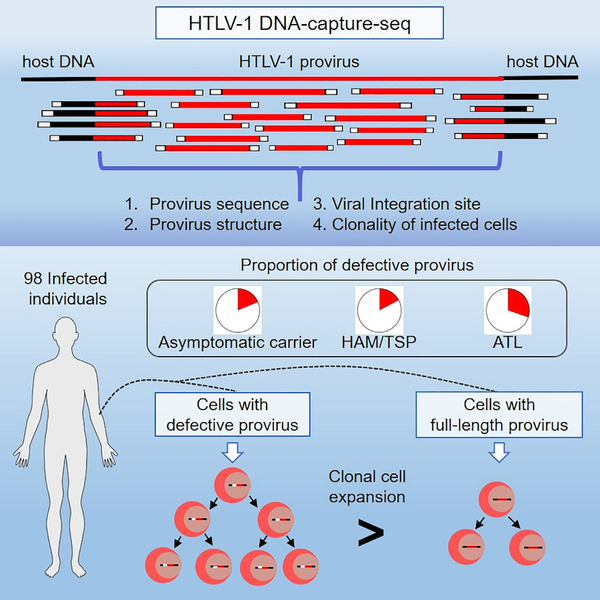- HOME
- News & Events
- Publications
- 【Publications】The nature of the HTLV-1 provirus in naturally infected individuals analyzed by the vi...
Publications
【Publications】The nature of the HTLV-1 provirus in naturally infected individuals analyzed by the viral DNA-capture-seq approach
October 23 2019
Hiroo Katsuya
Paper information
Hiroo Katsuya, Saiful Islam, Benjy Jek Yang Tan, Jumpei Ito, Paola Miyazato, Misaki Matsuo, Yuki Inada, Saori C. Iwase, Yoshikazu Uchiyama, Hiroyuki Hata, Tomoo Sato, Naoko Yagishita, Natsumi Araya, Takaharu Ueno, Kisato Nosaka, Masahito Tokunaga, Makoto Yamagishi, Toshiki Watanabe, Kaoru Uchimaru, Jun-ichi Fujisawa, Atae Utsunomiya, Yoshihisa Yamano, and Yorifumi Satou
The nature of the HTLV-1 provirus in naturally infected individuals analyzed by the viral DNA-capture-seq approach.
Cell Reports. 2019 October 15. 29, 724-735, https://doi.org/10.1016/j.celrep.2019.09.016
Highlights
- A method for comprehensive analysis of HTLV-1 proviruses in infected individuals
- The method provides viral sequence, integration site, and degree of cell expansion
- Defective proviruses are present in asymptomatic carriers and HAM/TSP, as well as ATL
- Infected cells with defective proviruses proliferate more than those with intact ones
Abstract
The retrovirus human T-cell leukemia virus type 1(HTLV-1) integrates into the host DNA, achieves persistent infection, and induces human diseases. Here, we demonstrate that viral DNA-capture sequencing (DNA-capture-seq) is useful to characterize HTLV-1 proviruses in naturally virus-infected individuals, providing comprehensive information about the proviral structure and the viral integration site. We analyzed peripheral blood from 98 naturally HTLV-1-infected individuals and found that defective proviruses were present not only in patients with leukemia, but also in those with other clinical entities. We further demonstrated that clones with defective-type proviruses exhibited a higher degree of clonal abundance than those with full-length proviruses. The frequency of defective-type proviruses in HTLV-1-infected humanized mice was lower than that in infected individuals, indicating that defective proviruses were rare at the initial phase of infection but preferentially selected during persistent infection. These results demonstrate the robustness of viral DNA-capture-seq for HTLV-1 infection and suggest potential applications for other virus-associated cancers in humans.
